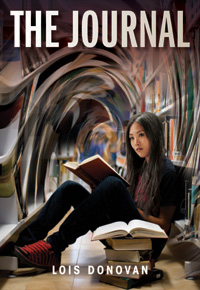| ________________
CM . . .
. Volume XXI Number 31. . . .April 17, 2015

 |
The Journal.
Lois Donovan.
Vancouver, BC: Ronsdale Press, 2015.
198 pp., trade pbk., e-book & pdf, $11.95 (pbk.).
ISBN 978-1-55380-350-8 (pbk.), ISBN 978-1-55380-351-5 e-book), ISBN 978-1-55380-352-2 (pdf).
Grades 4-9 / Ages 9-14.
Review by Beth Maddigan.
***½ /4
|
| |
|

excerpt:
The woman rose from her chair and shook hands with Mr. and Mrs. Mitchell. She was more sturdy than beautiful, but she carried herself regally with an air of importance. And although the firm set to her jaw gave the impression she was a no-nonsense type, her eyes, when they met mine, were warm.
“Hello Millie, Jack. Please call me Emily. We are friends, so there’s no need to hold with the formalities. I want to assure you that you have done the right thing in bringing the girl to me. I deal with these young women all the time.”
Emily? Emily Murphy? You’ve got to be kidding. No wonder she looked familiar. I had seen her picture in my seventh-grade Social Studies text book when we studied famous Canadians. This judge. This woman judge from 1929 had to be Emily Murphy. The Emily Murphy. She had been the first female magistrate in the entire British Empire and an activist for women’s rights. Wow. This was crazy.
Moving to a new city just before her thirteenth birthday leaves Kami Anderson feeling unsettled and disoriented. Her spot on the school soccer team and plans for a joint birthday party with her best friend are abandoned as Kami and her mother, urban designer, Keiko Kishida, move from Vancouver to Edmonton. They take up residence in Kami’s paternal grandfather’s house, a house Kami will inherit when she turns eighteen. With the potential to reconnect with her estranged father on the horizon, Kami explores the contents of the house and uncovers her great-grandmother Helen’s journal, an artifact that pulls Kami back to the winter of 1929.
Helen was Kami’s age when she wrote the journal and inserted newspaper clippings of articles written by her parents. Reading the journal, Kami feels an instant connection to her great grandmother. When she delves further into the newspaper articles, she activates a time portal that takes her back to Helen’s world of 1929. Kami is bold and doesn’t consider the ramifications of inserting herself into the past, and these insertions do cause some threads in the carefully woven storyline to unravel. Starting with the Starbucks Fruit and Nut bar she gives World War I fighter pilot Wilfrid “Wop” May and Vic Homer before their 1929 Mercy Flight and following with conversations and journal notations, Donovan does an admirable job of weaving these threads back into the fabric of the story at the end. Fantasy fans, however, might question the implications of modifying history, especially given that Kami interacts directly with some famous Canadians.
While The Journal is a fantasy novel, its strongest connections are rooted in historical fiction. This reviewer looked up several facts and enjoyed learning that there is a deep historical context for the entire 1929 thread. Emily Murphy, member of the Famous Five, was instrumental in bringing the Persons case to fruition, a landmark for women’s rights. Donovan makes a bold choice to put Kami face to face with Murphy and other famous historical figures of the time. The depth of the historical backstory is very impressive from the celebration modelled on the Famous Five’s Pink Teas, to the duties of young domestic workers, to the media interest in the fighter pilots' brave delivery of diphtheria medicine to Northern Alberta.
In addition to fans of historical fiction, this novel will likely be popular with teachers and librarians who champion critical literacy or encourage social justice discussions in their classrooms. There are numerous thought-provoking themes and questions in the pages of this novel that encourage readers to challenge the status quo and question their own belief systems. Themes of heroism, racism, social inequality, and historical interpretation are interwoven in this time-travel adventure. Kami and the other characters are portrayed as real people with flaws and strengths, making them relatable and realistic for the reader.
Highly Recommended
Beth Maddigan is Memorial University of Newfoundland’s Education Librarian.

To comment
on this title or this review, send mail to cm@umanitoba.ca.
Copyright © the Manitoba Library Association. Reproduction for personal
use is permitted only if this copyright notice is maintained. Any
other reproduction is prohibited without permission.
Next Review | Table of Contents For This Issue - April 17, 2015
CM Home | Back Issues
| Search
| CM Archive
| Profiles Archive
|
